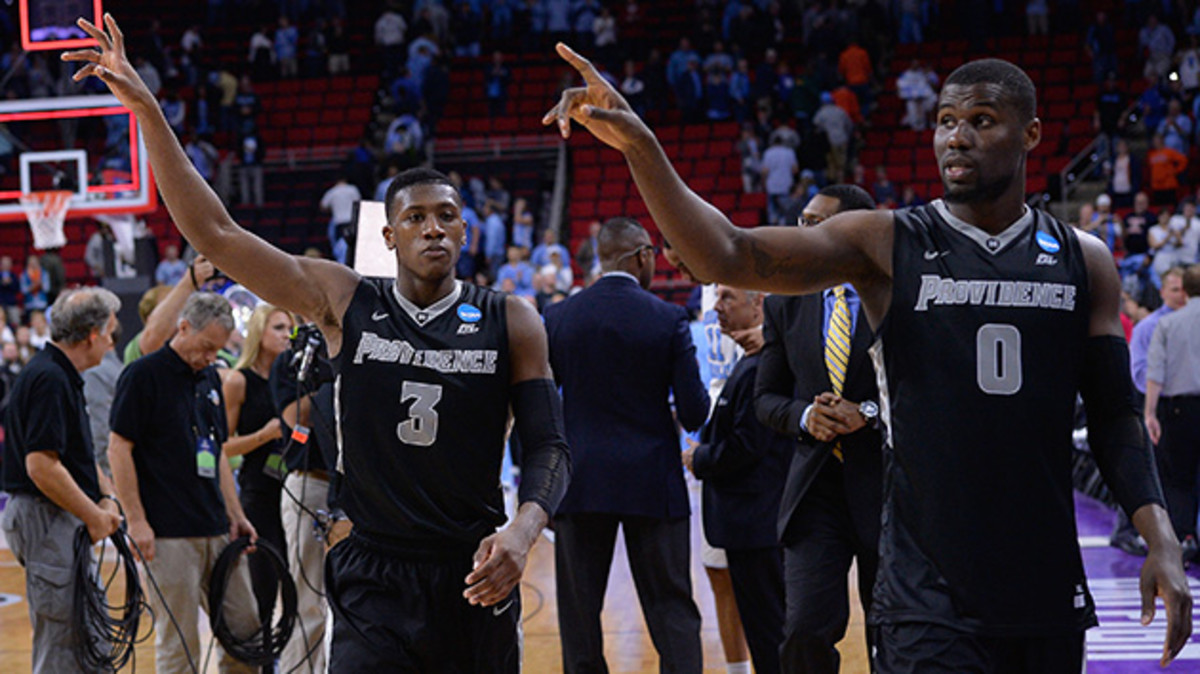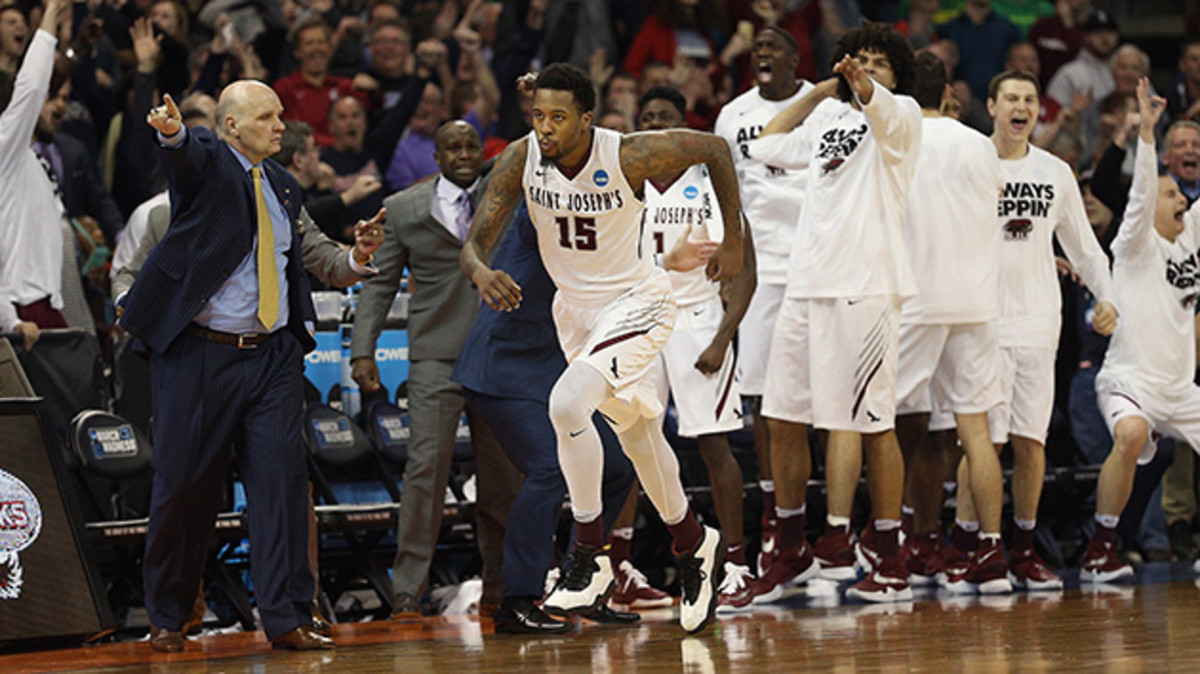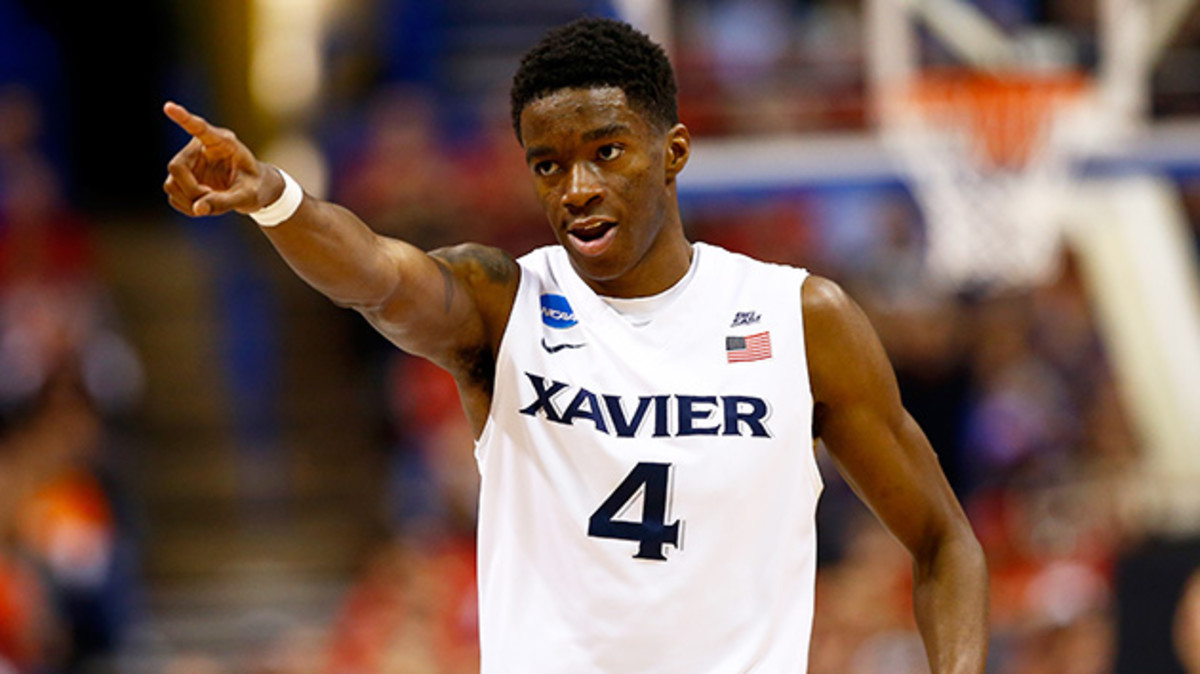Ten most surprising players this season

Get all of Chris Johnson’s columns as soon as they’re published. Download the new Sports Illustrated app (iOS or Android) and personalize your experience by following your favorite teams and SI writers.
Every college basketball season features hundreds of players who exceed expectations. Their performance is considered “surprisingly” good. This is a subjective concept that is bound to create controversy, but SI.com attempted to highlight 10 players who fit the bill. They are listed in alphabetical order.
Jaylen Adams, St. Bonaventure
Sophomore guard,17.9 ppg, 5.0 apg, 3.7 rpg
Adams made the proverbial sophomore leap in 2015–16. His three-point percentage rose from 32.4 to 43.8, he drew more fouls and converted more of his tries from the free throw line, and he played 95.3% of available minutes during Atlantic 10 play, the second-highest rate in the conference, after playing only 51.8% in 2014–15. And when Adams wasn’t on the floor, the Bonnies’ offense sputtered; they averaged 0.14 fewer points per possession. It’s a shame Adams didn’t get to put his talents on display in the NCAA tournament—St. Bonaventure definitely had a compelling case—but his performance going forward won’t be a surprise: Now we know Adams is good.
O.G. Anunoby, Indiana
Freshman forward, 4.9 ppg, 2.6 rpg, 0.5 apg
Senior Yogi Ferrell had already established himself as one of the nation’s best point guards. Freshman Thomas Bryant was expected to make a big impact as one of the top center recruits in the class of 2015. Yet few expected Anunoby, a three-star small forward in the same class, to perform as well as he did in his first season of college basketball. He scored a combined 27 points on 12-of-13 shooting in consecutive games against Michigan and Chattanooga in the Big Ten and NCAA tournaments, respectively, and distinguished himself as a versatile defender—all while climbing up early 2017 NBA mock drafts. With Ferrell leaving this off-season, Anunoby should have more offensive opportunities in 2016–17.

Ben Bentil, Providence
Sophomore forward, 21.1 ppg, 7.7 rpg, 1.1 bpg
SI tabbed friars junior point guard Kris Dunn as a second-team preseason All-America. Yet few foresaw Bentil making such a profound leap in his second season on campus. The 6'9" sophomore led Providence by averaging 24.6 points per 40 minutes, ranked fourth in the Big East in Player Efficiency Rating and third in Win Shares. Bentil also excelled at drawing fouls (7.1 per 40 minutes in conference play), cashed in at the free throw line (80.4% in conference play) and rated out as the Friars’ best rebounder on both ends of the floor. Bentil and Dunn formed one of the most potent inside-out duos in the country this season, but they’ve both declared for the draft.
• MORE: Ranking the five best title games of the modern era
Chris Boucher, Oregon
Senior forward, 12.1 ppg, 7.4 rpg, 3.1 bpg
Let’s not pretend that Boucher was anonymous before his first season at Oregon. He was named the National Junior College Athletic Association Division I national player of the year and was rated the No. 3 prospect in the class of 2015 on jucorecruiting.com. That said, few players were more effective defensively this season than Boucher was with the Ducks. He swatted a higher percentage (12.2) of opponents’ two-point field goal attempts than any other player in the Pac-12 during conference play and also rebounded about a fifth of opponents’ missed shots. Boucher also acquitted himself well offensively, converting 72.0% of his two-point field goal attempts against Pac-12 competition.
Mike Daum, South Dakota State
Freshman forward, 15.2 ppg, 6.1 repg, 0.8 apg
Daum arrived at South Dakota State as an unranked recruit with no reported scholarship offers from major-conference programs. But after redshirting last season, he blossomed into a star for the Jackrabbits in 2015–16. The Dauminator drew nearly eight fouls per 40 minutes, the sixth-highest rate in the country; converted 82.6% of his free-throw attempts; led the Summit League in Win Shares per 40 minutes; and ranked in the top five of the conference during conference play in offensive and defensive rebounding percentage, two-point field goal percentage and offensive rating. “I didn’t see myself where I’m at right now,” Daum told the Lincoln Journal Star in March.

Isaiah Miles, Saint Joseph’s
Senior forward, 18.1 ppg, 8.1 rpg, 1.0 bpg
Last Fall SI.com pegged Deandre’ Bembry as one of the top wings in the country. Most college basketball fans didn’t know anything about his teammate Miles, in part because he hadn’t played that well in two previous seasons with the Hawks. In 2015–16 Miles shot a higher percentage inside and outside the three-point line, drew more fouls and converted his free throws at a better clip and sliced his turnovers an route to being named the Atlantic 10’s most improved player. One important change Miles made prior to this season? “I gave up Baconators at Wendy’s,” he told The Baltimore Sun in March.
• MORE: Duke is the team to beat in 2017
Duncan Robinson, Michigan
Sophomore guard, 11.2 ppg, 3.5 rpg, 1.8 apg
Robinson was billed as an excellent shooter before he played his first game with the Wolverines. But it remained to be seen, after he redshirted a season following his transfer from Division III Williams College, how Robinson would handle a massive leap in competition—from the New England Small College Athletic Conference to the Big Ten. Robinson did not seem to have much trouble. He sank 44.8% of his threes, led Michigan with a 123.6 offensive rating and helped push the Wolverines to the NCAAs despite only having their best player, senior guard Caris LeVert, for 15 games this season.
Wayne Selden Jr., Kansas
Junior guard, 13.8 ppg, 3.4 rpg, 2.6 apg
Selden was heralded as one of the top perimeter recruits in the class of 2013, but he largely underwhelmed for two years in Lawrence. Selden hinted at a potential breakout season when he shone at the World University Games last summer, and he delivered by recording his best college season yet. Selden increased his scoring efficiency and took better care of the ball while helping Kansas clinch at least a share of its 12th consecutive Big 12 title. While Selden’s season should be appreciated in full, there is one enduring image: His one-handed posterization against Baylor in the conference tournament that prompted a Vine-worthy celebration from his uncle in the stands.

Edmond Sumner, Xavier
Freshman guard, 11.0 ppg, 3.4 rpg, 3.6 apg
Sumner was a four-star recruit out of Detroit County Day (Mich.) School, but his college career hit an early snag: Knee tendinitis caused him to redshirt in 2014–15. Sumner made the most of his first full season of college basketball. The 6'6" point guard assisted on about a fourth of the Musketeers baskets, got to the free throw line frequently (6.2 fouls drawn per 40 minutes) and disrupted opposing backcourts on the other end of the floor, ranking fourth in the Big East during conference play with a 3.4 steal percentage. His two-way play was critical in Xavier’s run to 28 wins and its highest tourney seed (2) in program history.
Derek Willis, Kentucky
Junior forward, 7.7 ppg, 4.0 rpg, 0.7 bpg
After losing Karl Anthony-Towns, Willie Cauley-Stein, Trey Lyles and Dakari Johnson to the NBA draft last season, Kentucky managed to trot out another strong starting frontcourt this season. The Wildcats brought in the top overall recruit in the class of 2015, center Skal Labissiere, to join returners Alex Poythress and Marcus Lee. Yet Kentucky ultimately needed contributions from Willis, a former three-star prospect who played just 4.8% of available minutes in 2014–15. During SEC play, Willis made half of his 70 three-point attempts and posted the highest offensive rating in the conference. His ability to stretch the floor helped Kentucky rank fifth nationally in adjusted offensive efficiency.
Statistical support from sports-reference.com and kenpom.com.
